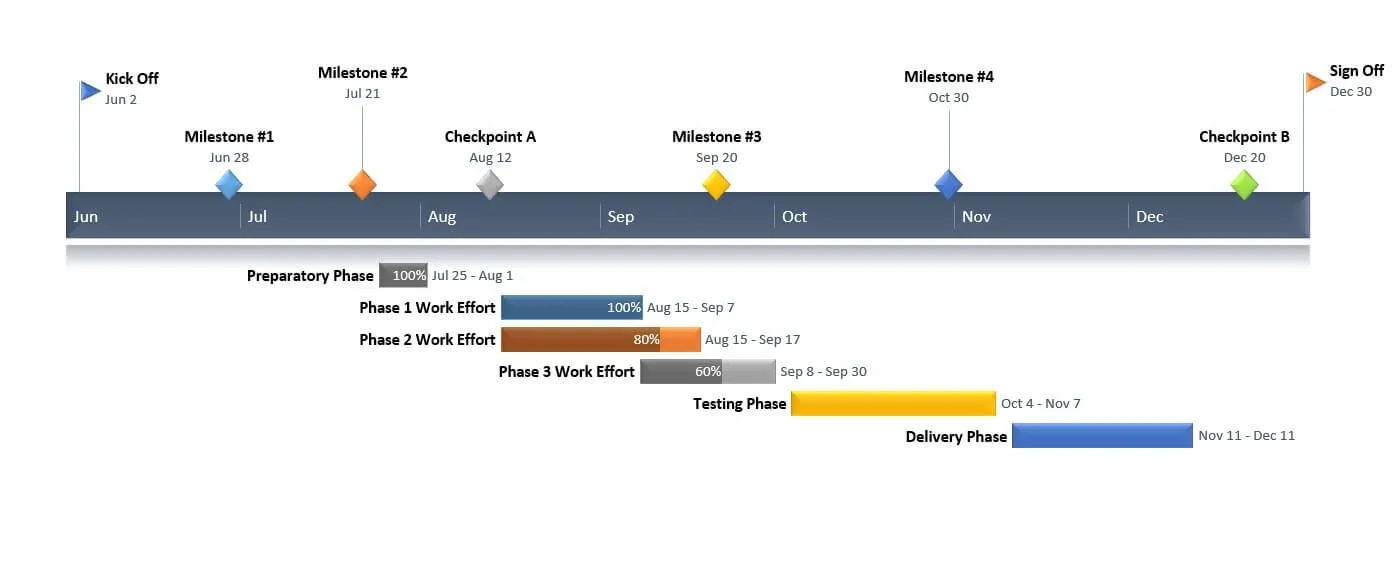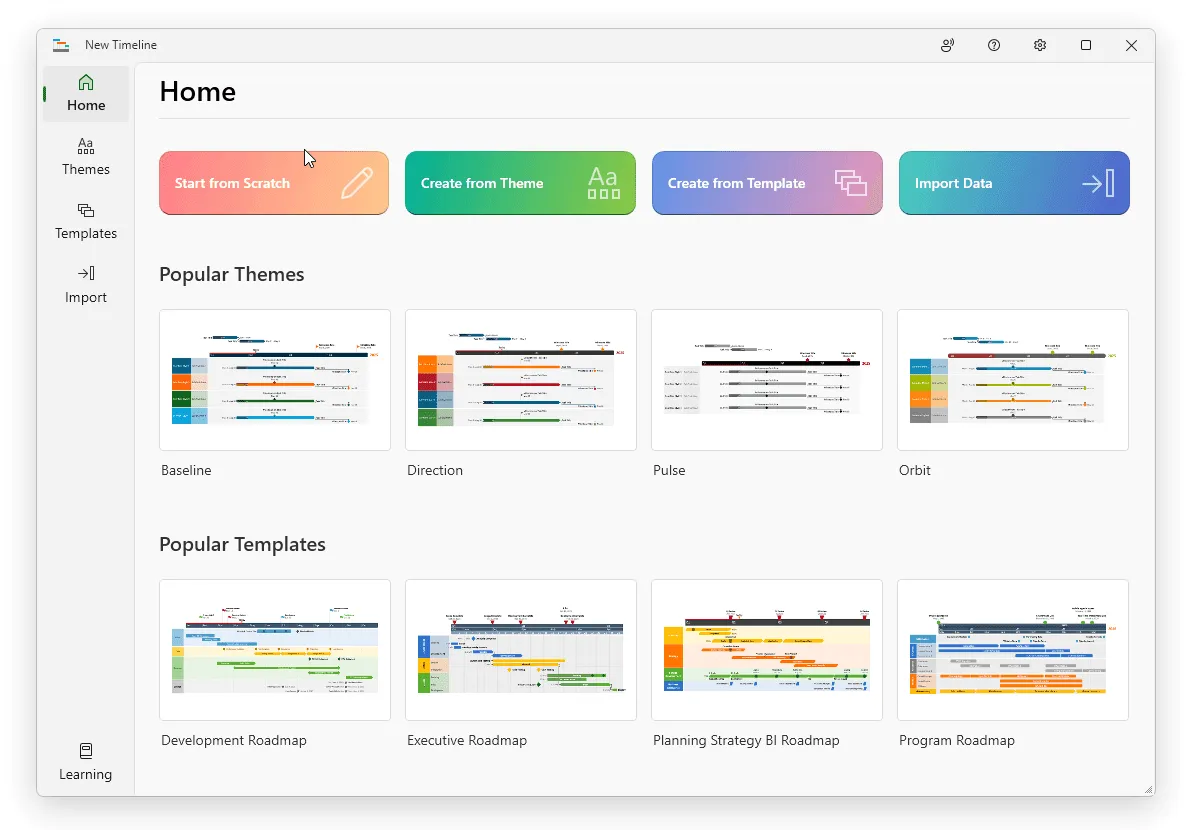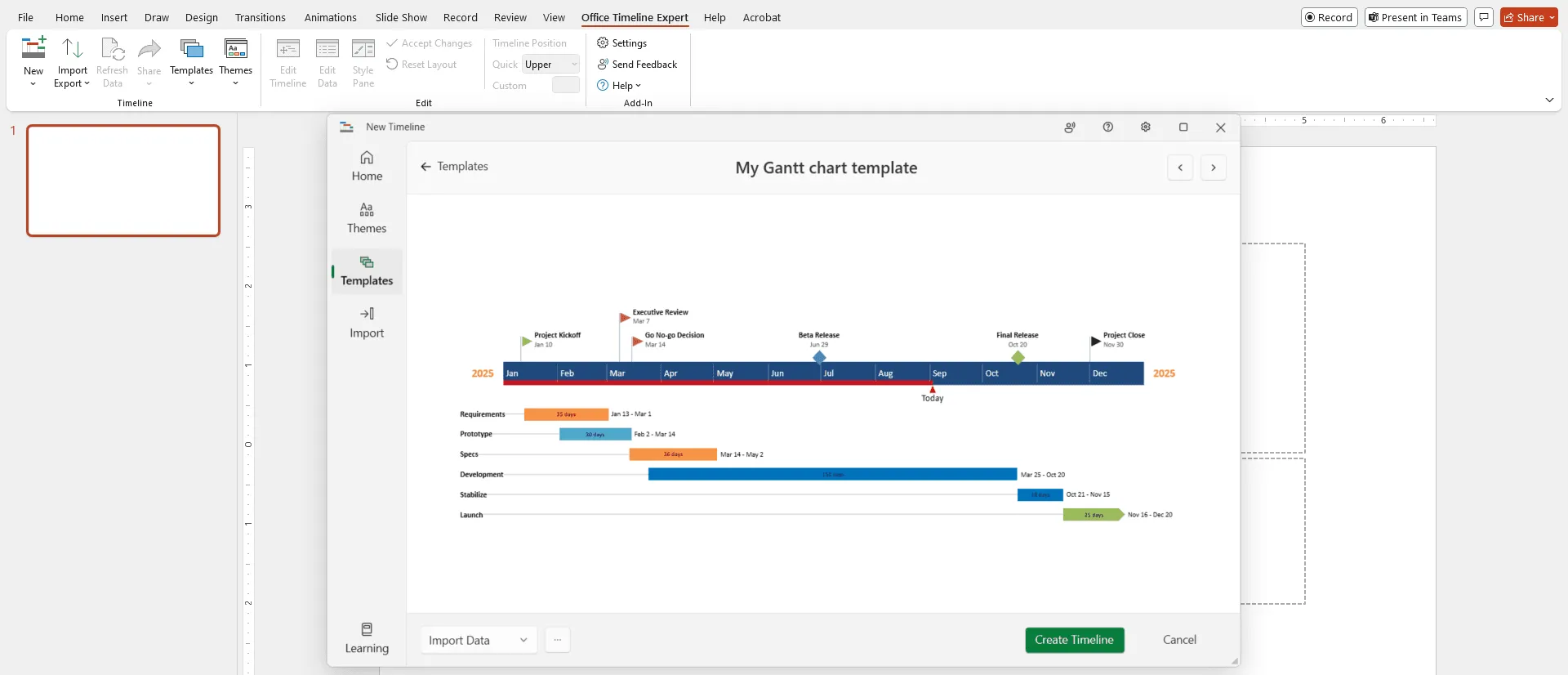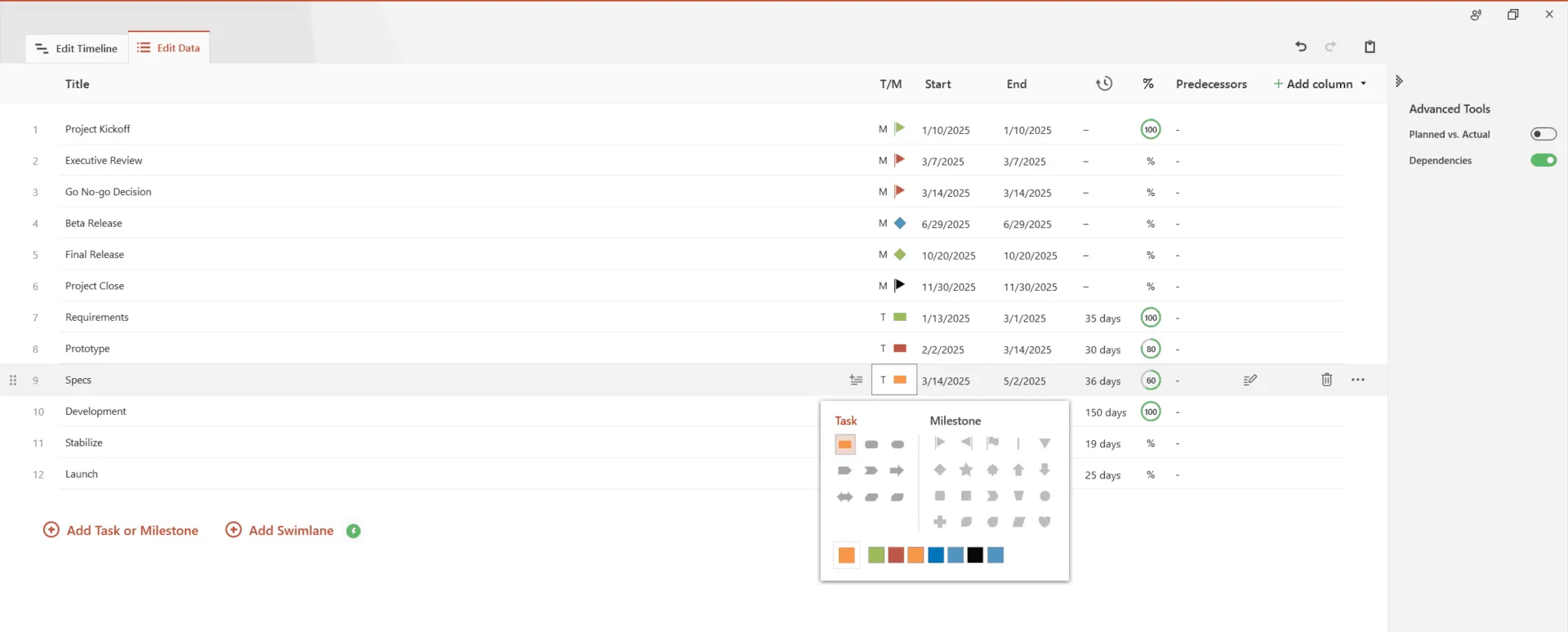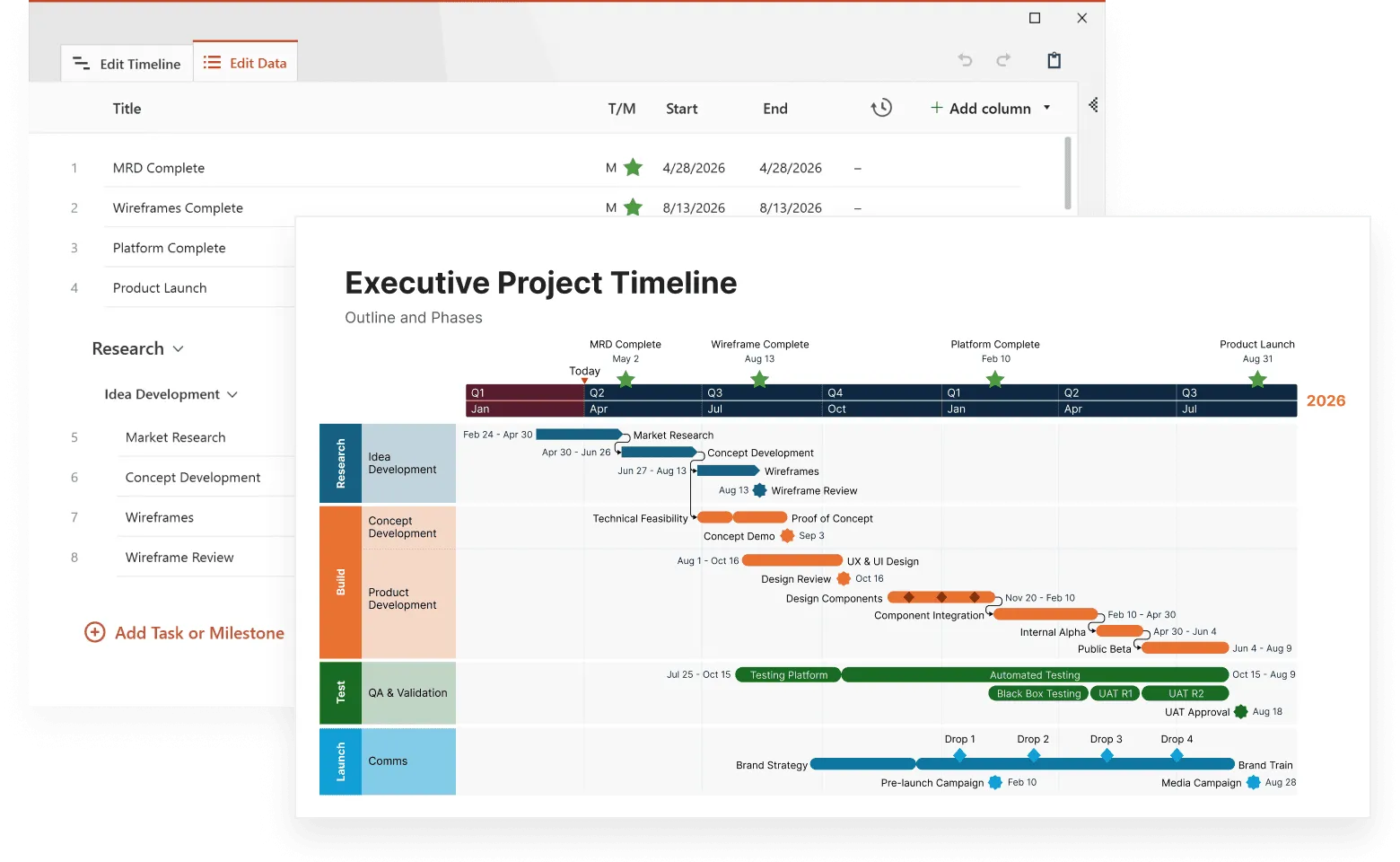Professionals who wish to create a Gantt chart in Microsoft Word can do so using the tool’s Stacked Bar feature and some manual formatting. However, since the software is primarily designed for editing copy and lacks a built-in Gantt feature, it may not offer too much flexibility when it comes to more refined customizations or regular updates.
If you need to create impressive Gantt charts and update them frequently for recurring presentations, PowerPoint may prove faster and more efficient. Below, we will demonstrate how to make a Gantt chart both manually in Word and automatically in PowerPoint.
Which tutorial would you like to see?
How to manually make a Gantt chart in Microsoft Word
1. Build a basic stacked bar graphic.
a) Open a new Word document and set the orientation of the page from Portrait to Landscape to get more space for your Gantt chart. To do so, go to the Layout tab on the Word ribbon and click on Orientation.
b) Go to the Insert tab and select Chart from the Illustration section.
c) In the All Charts window that pops up, select the Bar category and choose Stacked Bar as the type of graphic to use for your Gantt chart.
2. Add your project schedule data.
Once you complete the steps above, Word will generate a standard chart like the one below along with an Excel table where you can replace the placeholder data with your own.
Quick tip: You can change the type, style, and color scheme of your chart from the Design tab highlighted in the image above or by clicking on the small brush symbol on the right side of the graphic. You can also resize the visual by clicking on the chart area and dragging its sizing handles until you reach the desired height and width.
To begin working on your Gantt chart, you first need to outline the main phases or tasks of your project. Once you determine the project tasks, you can then assign a start date, end date and duration (number of days in which a task is carried out) to each of them:
a) Enter your tasks’ descriptions or titles in column A of the Excel table visible in your Word document. As you list the task names, the items will be stacked upwards on the graphic, the first task being displayed at the bottom of the graphic and the last one at the top.
b) Rename the columns entitled Series 1, Series 2, and Series 3 into Start Date, End Date, and Duration (days), respectively.
c) To properly display the start and end dates of your tasks, you may wish to format columns B and C before entering your data. To do so, select the two columns, right-click on them, and choose Format Cells from the shortcut menu. In the dialogue box that pops up, pick Date from the Category list, and select the desired date format from the Type menu.
d) Once the right format for columns B and C is set, you can type in your tasks’ Start and End dates. Note: Don’t worry if the graphic seems to be off after you enter the dates. We will fix this quickly as soon as we fill out the Duration column.
e) Calculate the duration of your first task by typing the formula =$C2-$B2 in cell D2. Then, select the cell and drag its fill handle downwards across column D. This will apply the same formula to the rest of the cells under Duration.
f) Now that you’ve calculated the task durations, you don’t need the End Date series anymore, so you can remove it from the graphic to make the Duration series visible. To do so, select the chart and then:
i. Click on the Chart Filters button (the funnel symbol on the right side of the graphic);
ii. Uncheck the box to the left of End Date, under the Series group;
iii. Click on Apply.
Once you’ve filtered out the End Dates, your chart should look like this:
3. Turn your graphic into a Gantt chart.
Now your graphic is getting closer to a Gantt chart, but it’s not quite there yet. To turn it into a Gantt, you’ll need to make the blue bars transparent so that only the grey ones remain visible. The remaining bars will represent the tasks of your Gant chart. To do this:
a) Click on any of the blue bars on your chart to select the whole series.
b) Right-click on the selection.
c) In the mini toolbar that pops up, click on the Fill button, and select No Fill.
The resulting Gantt chart should look like this:
4. Customize your Gantt chart.
With your Gantt chart ready, you can now make further customizations to personalize it and make it better fit for presentations.
a) To make your graphic stand out more, you can apply a variety of styles and effects to it from the Chart Tools Format tab on the Word ribbon. In our example, we chose to add a slight shadow to the plot area using Shape Effects, and we also applied a Quick Style to all the tasks to make them pop out.
b) You can also recolor individual tasks to draw attention to particular phases or activities. To do so, select the desired task bar (you may need to click on it twice), then right-click on it, and then go to Fill in the shortcut menu to change its color.
c) If you want to reverse the tasks’ order, double-click the list of task descriptions on the left side of the chart. Then, in the Format Axis pane that opens, you need to tick the checkbox in front of Categories in reverse order, under the Axis Options group.
You will notice that the first task is now displayed at the top of your Gantt chart and the last one at the bottom, with the date markers also moved from beneath to the top of the graphic.
d) To bring the task bars closer to the vertical axis of your graphic, double-click on the date series above the bars to open its settings in the Format Axis pane on the right. Here, in the Axis Options group, increase the Minimum number under the header called Bounds to adjust the leftmost boundary of your chart. In our case, we changed the initial number from 44300.0 to 44400.0.
e) In our example, we also decreased the width of our task bars so there would be more space between them on the graphic. To do the same, select your tasks and then:
i. Right-click on the selection and choose Format Data Series from the shortcut menu that appears;
ii. On the right, under Series Options, increase the percentage in the box next to Gap Width. For our Gantt chart, we raised it to 175%.
f) Finally, you may also want to remove the legend generated automatically by Word as it can be a little confusing. Simply select it, press Delete, and that’s it. In the end, your final Gantt chart can look similar to this:
Download MS Word Gantt chart template
If you’d like to use the Gantt chart created in this guide as a template to help you move faster, you can download the file below, free of charge.
Get this free Gantt chart template

How to automatically make a Gantt chart in PowerPoint
Making a Gantt chart in Microsoft Word is possible but customizing and updating it can turn out to be too time-consuming. PowerPoint is a faster and simpler choice if you need to build impressive visuals for recurring communications.
Below you will learn how to automatically create a Gantt chart in PowerPoint using a lightweight add-in called Office Timeline. To get started, you first need to install Office Timeline's free trial, which will add a Gantt chart maker tab to the PowerPoint ribbon.
1. Open PowerPoint and add your data into the Office Timeline wizard.
a) Go to the Office Timeline tab on the PowerPoint ribbon and click on New.
You will be taken to a gallery with a variety of Gantt chart templates and styles you can choose from.
b) Select the template you want to use for your graphic by double-clicking on it, and then click Create timeline in the preview window. For our example, we will choose a custom Gantt chart template made earlier.
c) Now, in the Data Entry wizard, you can either enter your task descriptions and dates manually or copy-paste them from an existing Excel schedule. This is where you can also start making a few styling choices, such as changing the shape or color of each task. When ready, click the Create button.
2. A new Gantt chart slide will be instantly generated in PowerPoint.
a) Depending on the template used and the styling choices you make, you can get a Gantt chart slide similar to this:
b) Once you’ve generated your Gantt chart, you can restyle or update it automatically with Office Timeline. You can add or edit data at any time, change fonts, colors, shapes, positions or spacing, and include extras such as Time Elapsed, Task Duration or Notes. In our example above, we chose to insert a few milestones too, reposition task titles, and add Percent Complete to make the visual clearer.
Download PowerPoint Gantt chart template
If you’d like to use the timeline created in this guide as a template to help you move faster, you can download the file below, free of charge.
Get this free Gantt chart template

See how to build a PowerPoint Gantt chart in under 1 minute:
Play Video
FAQs about making Gantt charts in MS Word
This section provides the answers to the most frequently asked questions on making a Gantt chart in MS Word.
Developed as a word processing platform, Microsoft Word does not include any pre-designed Gantt chart templates that can be readily updated with your own data. However, the software does allow you to build a basic Gantt starting from a Stacked Bar Chart that you need to manually format.
As our tutorial above has demonstrated in detail, here are the main steps you need to take in order to make a Gantt chart using Microsoft Word:
- Insert a basic Stacked Bar Chart in your MS Word document.
- Add your project schedule data to the chart.
- Format your graphic into a Gantt chart by making part of your chart bars invisible.
- Customize your Gantt by recoloring your tasks, adjusting the gap between the chart bars or by reversing their display order.
As an easier and much faster alternative, you can create a Gantt in PowerPoint by copying and pasting your project data from Excel with the help of an intuitive Gantt chart maker add-in called Office Timeline. Find out how to do so with our short video below:

